Mising Traditional Dress
In This Beautiful Article, We Will Discuss The Missing Tribes and Their Mising Traditional Dress, Culture, and History. First I want to Thank You For Visiting Our Blog, Our Blog Is Completely Dedicated To sharing the Tradition, Culture, and History Of Bharat.
What Is Mising Tribe?
The Mising tribe is a large and vibrant indigenous ethnic group in Assam and Arunachal Pradesh. They are the second largest tribe in Assam, with a population of over 700,000 people. The Mising are known for their unique culture and traditions, which are closely tied to the land and riverine environment.
Visit Now:
The Mising people have a rich oral tradition, which includes myths, legends, and folktales. They also have a strong sense of community and kinship. The Mising are known for their hospitality and generosity.
The Mising people have faced a number of challenges in recent years, including land alienation, environmental degradation, and economic marginalization. However, they remain a resilient people, and they continue to fight for their rights and their culture.
The Mising people are an important part of Assam’s cultural mosaic. They contribute to the state’s economy, its social fabric, and its rich cultural heritage. It is important to recognize and support the Mising people, and to ensure that they have the opportunity to thrive in the 21st century.
What is the name of Mising Traditional Dress?
The Mising Traditional Dress is called the Yakan Age-Gasar. It is a black Mekhela Chador, which is a two-piece garment consisting of a long skirt and a draped shawl. The skirt is made of cotton, and it is typically decorated with simple geometric patterns. The shawl is also made of cotton, and it is often decorated with more elaborate designs,
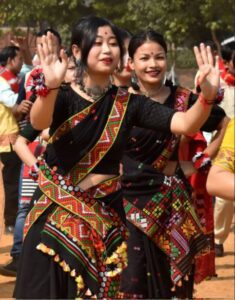
The Yakan Age-Gasar is worn by Mising women on all special occasions, such as weddings, festivals, and religious ceremonies. It is also worn by women during traditional dances and performances.
The Yakan Age-Gasar is a symbol of Mising identity and culture. It is a reminder of the Mising people’s connection to their land and their traditions.
In addition to the Yakan Age-Gasar, Mising men also have a traditional dress called the Gonru Ugon. It is a dhoti, which is a long piece of cloth that is wrapped around the waist and legs. The Gonru Ugon is typically made of cotton, and it is often decorated with simple stripes or checks.
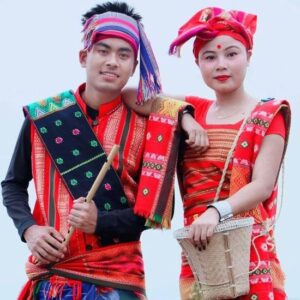
The Gonru Ugon is worn by Mising men on all special occasions, such as weddings, festivals, and religious ceremonies. It is also worn by men during traditional dances and performances.
The Gonru Ugon is a symbol of Mising identity and culture. It is a reminder of the Mising people’s connection to their land and their traditions.
The Mising people are proud of their traditional dress, and they continue to wear it today as a way to celebrate their culture and heritage.
Mising Traditional Dress for Men:
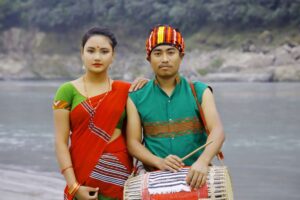
Mibu Galuk: A Mising Traditional Dress
Mibu Galuk is a sleeveless jacket worn by Mising men on special occasions. It is typically made of cotton or silk and comes in a variety of colors, including black, red, green, and blue. The jacket is decorated with intricate embroidery and appliqué work, often depicting traditional Mising symbols and motifs.
Erpob: A Mising Traditional Dress
Erpob is a wrap-around cloth that goes over the shoulder and is worn by Mising men on special occasions. It is typically made of red cotton cloth with different stripes. The Erpob is decorated with tassels and beads, and it is often worn with the Mibu Galuk.
Ugon (Dhoti): A Mising Traditional Dress
Ugon is a white cloth worn as a lower garment by Mising men. It is similar to a dhoti, but it is typically made of finer fabric and is more tightly woven. There are two types of Ugon: a simple one for daily wear and a decorative one for special occasions. The decorative Ugon is often embroidered with intricate designs.
Tapum-Gasor (Eri Shawl): A Mising Traditional Dress
Tapum-Gasor is a shawl made from Eri silk. It is worn by Mising men and women to stay warm in winter. The shawl is typically black in color with white stripes. It is also decorated with tassels and beads.
Dumer: A Mising Traditional Dress
Dumer is a multipurpose cloth that is used by Mising people for a variety of purposes. It is typically made of white cotton cloth with red borders. Dumer is used as a towel, a scarf, a blanket, and even a sling for carrying babies.
Jinrek or Tongali Dumer: A Mising Traditional Dress
Jinrek or Tongali Dumer is a longer cloth that is tied around the waist by Mising women. It is typically made of black cotton cloth with red borders. The Jinrek is used to cover the lower body and to keep warm. It is also used to carry items such as food and water.
Additional Details: About Mising Traditional Dress
The traditional Mising clothing is made from natural materials such as cotton, silk, and wool. The colors and designs of the clothing are often symbolic of the Mising culture and beliefs. For example, the color red is associated with fertility and prosperity, while the color white is associated with purity and cleanliness.
The traditional Mising clothing is a reflection of the tribe’s rich culture and heritage. It is worn on special occasions such as festivals, weddings, and funerals. The clothing is also worn by Mising people to express their identity and pride in their cultur
Mising Traditional Dress For Women:
Gero: A Mising Traditional Dress
Gero is a cloth worn around the waist and chest by Mising women. It is typically made of cotton or silk and comes in a variety of colors, including white, red, and black. The Gero is decorated with intricate embroidery and appliqué work, often depicting traditional Mising symbols and motifs.
Ege: A Mising Traditional Dress
Ege is a lower garment that covers the lower body by Mising women. It is typically made of cotton or silk and comes in a variety of colors, including white, black, and red. The Ege is decorated with simple designs, such as stripes or geometric patterns.
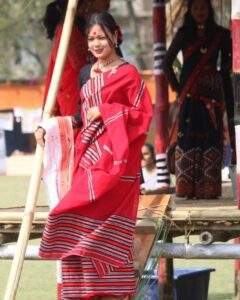
Sori Potali : A Mising Traditional Dress
Sori Potali is a similar cloth to Gero, but it has simpler designs. It is typically made of cotton or silk and comes in a variety of colors, including white, red, and black. Sori Potali is often worn by unmarried women.
Segreg: A Mising Traditional Dress
Segreg is a piece of cloth that is wrapped around the bust and sometimes used instead of a shawl by Mising women. It is typically made of cotton or silk and comes in a variety of colors, including white, red, and black. Segreg is often worn by married women.
Ku-Pob: A Mising Traditional Dress
Ku-Pob is a cloth worn by grown-up girls to cover the upper body. It is typically made of cotton or silk and comes in a variety of colors, including white, red, and black. Ku-Pob is decorated with simple designs, such as stripes or geometric patterns.
Mosang Gasor: A Mising Traditional Dress
Mosang Gasor is an upper garment that is often worn by unmarried women. It is typically made of cotton or silk and comes in a variety of colors, including white, red, and black. Mosang Gasor is decorated with intricate embroidery and appliqué work, often depicting traditional Mising symbols and motifs.
Ri: Bi: A Mising Traditional Dress
Ri: Bi is a woven cloth with stripes and simple designs. It is typically made of cotton or silk and comes in a variety of colors, including white, red, and black. Ri: Bi is worn by young girls on special occasions.
Gaseng: A Mising Traditional Dress
Gaseng is similar to Ri: Bi, but it has more red color. It is typically made of cotton or silk and comes in a variety of colors, including white, red, and black. Gaseng is worn by young girls on special occasions.
Pe, Re: A Mising Traditional Dress
Pe, Re is a type of Gero with stripes and colorful borders. It is typically made of cotton or silk and comes in a variety of colors, including white, red, and black. Pe, Re is worn by unmarried women and young girls.
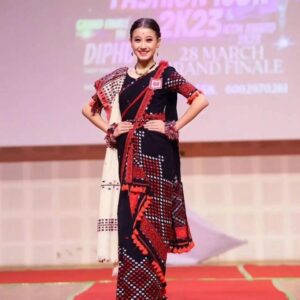
Seleng Gasor
Seleng Gasor is a cloth that is worn like a shawl. It is typically made of cotton or silk and comes in a variety of colors, including white, red, and black. Seleng Gasor is often worn by married women on special occasions.
Po: Tub: A Mising Traditional Dress
Po: Tub is a cloth that is used to cover the head during work, such as cooking or cleaning. It is typically made of cotton or silk and comes in a variety of colors, including white, red, and black. Po: Tub is often worn by married women.
Additional Details About Mising Traditional Dress
The traditional Mising clothing is made from natural materials such as cotton, silk, and wool. The colors and designs of the clothing are often symbolic of the Mising culture and beliefs. For example, the color red is associated with fertility and prosperity, while the color white is associated with purity and cleanliness.
The traditional Mising clothing is a reflection of the tribe’s rich culture and heritage. It is worn on special occasions such as festivals, weddings, and funerals. The clothing is also worn by Mising people to express their identity and pride in their culture.
It is important to note that the traditional Mising clothing varies from region to region. The cloths listed above are just a few of the many different types of traditional Mising clothing that exist.
In simple terms, Mising men wear jackets, cloths wrapped around their waist, and special shawls, while Mising women wear various types of dresses, including lower garments, upper garments, and shawls, often with colorful designs and patterns. These clothes are used for everyday wear as well as special occasions.
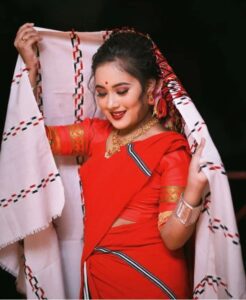
A Simple Overview on Culture of Mising Tribes:
The Mising people have a unique culture that is closely tied to the land and riverine environment. They are skilled hunters and fishermen, and they also practice agriculture and horticulture. The Mising people are known for their hospitality and generosity.
Some of the most important aspects of Mising culture include:
- Religion: The Mising people are predominantly Hindu and Christian, but they also retain some of their traditional animistic beliefs and practices.
- Food: The Mising people eat a variety of foods, including rice, fish, meat, and vegetables. They also have a number of traditional dishes, such as Apong (rice beer) and Doi Bur (a fermented soybean dish).
- Music and dance: The Mising people have a rich tradition of music and dance. They perform traditional dances at festivals and other special occasions.
- Arts and crafts: The Mising people are skilled weavers, blacksmiths, and potters. They produce a variety of traditional handicrafts, such as Yakan Age-Gasar (Mising traditional dress) and Gonru Ugon (Mising traditional men’s dress).
Festivals
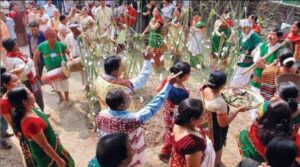
The Mising people celebrate a number of festivals throughout the year. Some of the most important festivals include:
- Ali-Aye-Leegang: This festival is celebrated in the month of December to mark the end of the agricultural season.
- Prhag: This festival is celebrated in the month of March to celebrate the beginning of the new agricultural season.
- Dobur: This festival is celebrated in the month of June to celebrate the harvest.
These festivals are important cultural events for the Mising people. They provide an opportunity for the community to come together and celebrate their shared culture and traditions.
The Mising people are a proud and resilient people. They have a rich culture and history that they are committed to preserving. The Mising people continue to play an important role in the social, economic, and cultural life of Assam.
Check Your Local Weather ForeCast: Click Here To Know
A Simple Overview on History of the Mising People:

The Mising people are indigenous to the Brahmaputra Valley and the foothills of Arunachal Pradesh in India. They are believed to have migrated to the region from Tibet many centuries ago. The Mising people have a rich oral tradition, which includes myths, legends, and folktales.
The earliest mention of the Mising people comes from the Ahom Buranjis, which are a collection of chronicles that document the history of the Ahom Kingdom, which ruled Assam from the 13th to the 18th centuries. The Ahom Buranjis refer to the Mising people as the Miris.
The Mising people were originally animists, but they have gradually converted to Hinduism and Christianity over the centuries. However, many Mising people still retain some of their traditional beliefs and practices. For example, many Mising people believe in the existence of spirits and deities, and they perform traditional rituals to appease these spirits.
The Mising people have faced a number of challenges throughout their history. They have been displaced by land alienation and development projects, and they have also been marginalized by the dominant Assamese society. However, the Mising people have remained a resilient people, and they have continued to fight for their rights and their culture.
In the early 20th century, the Mising people began to organize themselves politically. They formed a number of organizations to advocate for their rights and to promote their culture. In 1987, the Mising Autonomous Council was established in Assam. The Mising Autonomous Council is a self-governing body that has jurisdiction over a number of districts in Assam.
The Mising people are a proud and resilient people. They have a rich culture and history that they are committed to preserving. The Mising people continue to play an important role in the social, economic, and cultural life of Assam.
Some of the key events in the history of the Mising people include:
- 13th century: The Mising people are believed to have migrated to the Brahmaputra Valley from Tibet.
- 17th century: The Mising people are first mentioned in the Ahom Buranjis.
- 19th century: The Mising people begin to convert to Hinduism and Christianity.
- 20th century: The Mising people begin to organize themselves politically and establish the Mising Autonomous Council.
The Mising people have a long and rich history. They have faced many challenges throughout their history, but they have remained a resilient people. The Mising people are a proud and important part of the social, economic, and cultural life of Assam.
Also Read: Bodo Traditional Dress: Discover 9 Absolutely Gorgeous Pictures
What is the Mising tribe?
The Mising tribe is one of the largest tribes in Assam, India. They are a matrilineal tribe, which means that property and inheritance are passed down through the female line. The Mising people are known for their rich culture and traditions.
Where do the Mising people live?
The Mising people primarily live in the districts of Dhemaji, Lakhimpur, Tinsukia, and Dibrugarh in Assam, India. However, they can also be found in other parts of Assam and in other parts of India, such as Arunachal Pradesh and Nagaland.
What is the history of the Mising people?
The Mising people have a long and rich history that dates back centuries. They are believed to have migrated to Assam from Tibet and Myanmar. The Mising people have been involved in many historical events, such as the Assam Ahom kingdom and the Indian independence movement.
What is the culture of the Mising people?
The Mising culture is rich and diverse. It is influenced by a variety of factors, including their matrilineal system, their agricultural practices, and their religious beliefs. The Mising people have a number of traditional festivals and ceremonies, such as the Bihu festival and the Ali Axoni festival.
What are the traditional occupations of the Mising people?
The Mising people are traditionally farmers. They grow a variety of crops, including rice, maize, and millet. The Mising people also practice animal husbandry and fishing.
What are the traditional beliefs of the Mising people?
The Mising people are primarily animists. They believe in a variety of spirits, both good and evil. The Mising people also practice a form of ancestor worship.
What are the traditional arts and crafts of the Mising people?
The Mising people are skilled in a variety of arts and crafts, including weaving, pottery, and wood carving. The Mising people are also known for their traditional music and dance.
Disclaimer
The information provided in this overview of Mising culture and history is based on my understanding of the available sources. I have tried my best to be accurate and comprehensive, but I acknowledge that there may be some errors or omissions. If you find any mistakes, please let me know so that I can correct them.
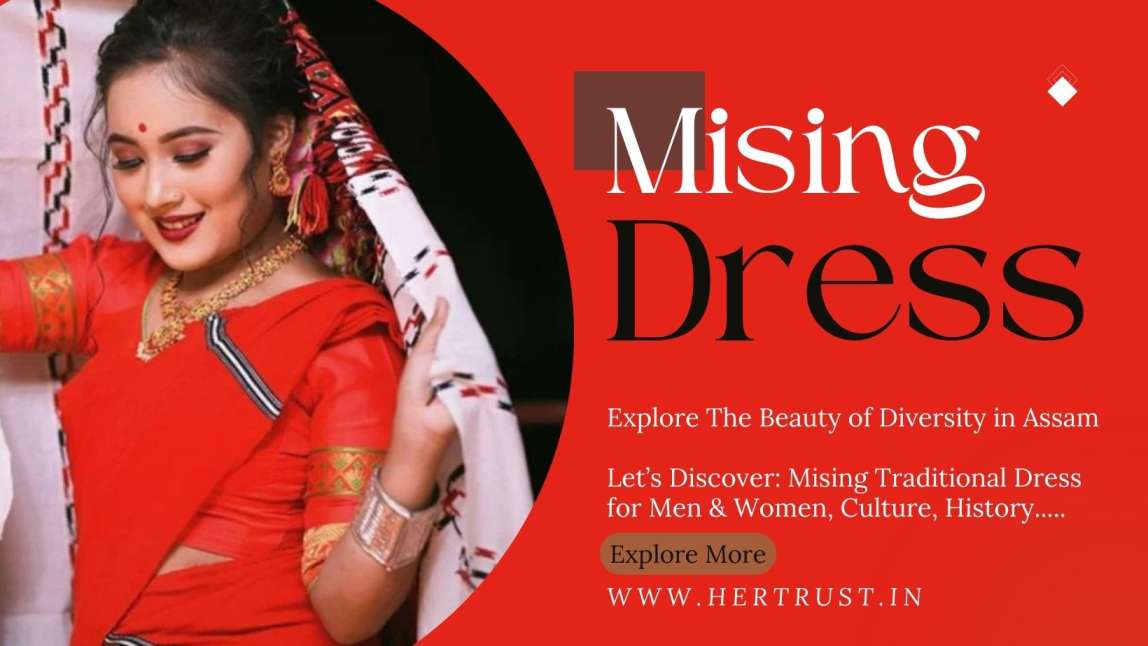


I am really grateful to the holder of this website who has shared this enormous article at at this place.
Remarkable! Its truly amazing piece of writing,
I have got much clear idea about from this article.
Hi there! Quick question that’s totally off topic. Do you know how to make your
site mobile friendly? My blog looks weird when viewing from my iphone.
I’m trying to find a theme or plugin that might be able to resolve this issue.
If you have any suggestions, please share. Thank you!
I’m not sure where you are getting your information, but
good topic. I needs to spend some time learning much more
or understanding more. Thanks for fantastic information I was looking for this info for my mission.
Hi i am kavin, its my first occasion to commenting anywhere, when i
read this article i thought i could also create comment due to this good piece of writing.
You made some really good points there. I checked on the web for additional information about the
issue and found most people will go along with
your views on this website.
I know this if off topic but I’m looking into starting my own blog and was wondering
what all is needed to get setup? I’m assuming having a blog like yours would cost a pretty penny?
I’m not very web savvy so I’m not 100% certain. Any recommendations or
advice would be greatly appreciated. Thanks
hi!,I love your writing very so much! share we communicate
more about your article on AOL? I need a specialist on this
space to solve my problem. May be that is you! Looking
ahead to see you.